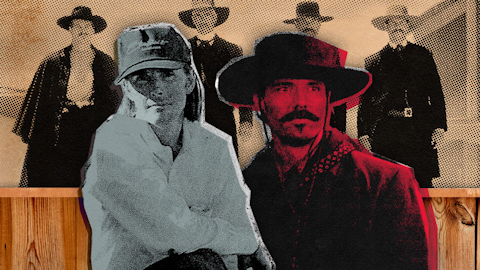At one point this past summer, we began to notice the movie Tombstone showing up on television an increasing number of times; over a two-week period, it was in heavy play on at least five networks, including two (CMT and the BBC) that don’t ordinarily carry movies. Tombstone’s appeal only seems to grow with time and it may be at its greatest now, 25 years since its release.
Michael Biehn, the movie’s indelible Johnny Ringo, frequently runs into fans from a range of backgrounds. For veterans of Iraq and Afghanistan, it was their “go-to” movie, that one cassette or disc every outpost played repeatedly. Troops adopted the lingo, calling each other things like “lunger” and “law dog.” Alpha-male admirers include police officers; one pulled up his shirt to display Ringo’s likeness sewn onto his Kevlar vest. The movie has no lack of female devotees, and younger fans often tell Michael that they have bonded with parents and grandparents while enjoying the movie together; Tombstone now boasts three generations of fans. It’s very much one of those compulsively watchable movies that whenever you come across it on television, you wind up watching again until the end credits roll. How odd it is, then, that a movie that now seems so perfectly realized was once a patient whose heart had stopped beating and required the movie equivalent of a defibrillator to start pumping again.
Long ago, Michael got used to hearing “I’m your huckleberry” when recognized — even though, of course, the line is uttered by his arch nemesis, Val Kilmer’s Doc Holliday. When his agent, Ed Limato, first sent him Kevin Jarre’s screenplay, Michael was told Kurt Russell was set for Wyatt; what other roles appealed to him? He immediately responded, “Doc Holliday,” but a few days later Limato told him the studio was leaning toward Kilmer. Michael knew instinctively that Johnny Ringo was the next-best character.
Jarre made a striking impression on Michael when they met for lunch. Lean, tall, good looking: He could have been a cast member. His enthusiasm for Tombstone was contagious; he had immersed himself in the details and was in command of the material. He answered all of Biehn’s questions about Johnny Ringo. Kevin revealed that his inspiration for the movie was to write something for actress Lisa Zane, with whom he was involved. She was his “muse,” he said, and he wrote the role of Josie — played by Dana Delaney — with her in mind. In the history of Tombstone, Josie Marcus was a pivotal character, and her role had greater presence in the screenplay.
Michael rode to Tucson with Powers Boothe, memorable as his saddle bro Curly Bill Brocius, who regaled him with a stream of funny stories. He had admired Powers’ acting for years, ever since his breakout performance as mass suicide cult leader Jim Jones in the 1980 CBSTV
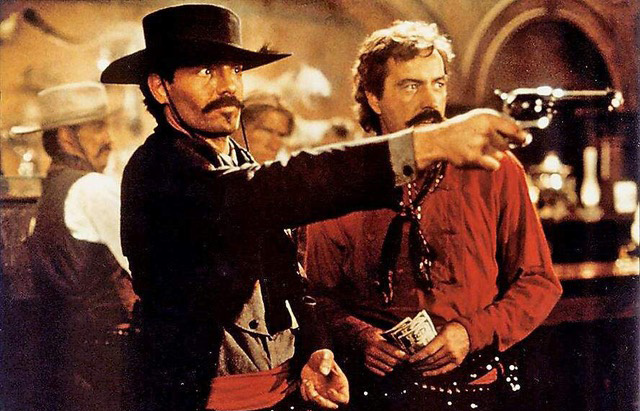 movie
Guyana Tragedy. Michael was in stitches during
Powers’ account of a “lost weekend” with Nick Nolte
on the set of Extreme Prejudice, when he stopped by
his co-star’s trailer for a brief end-of-theweek
celebration before heading home on a Friday and was
still there when a second assistant director
summoned them to the set Monday morning.
movie
Guyana Tragedy. Michael was in stitches during
Powers’ account of a “lost weekend” with Nick Nolte
on the set of Extreme Prejudice, when he stopped by
his co-star’s trailer for a brief end-of-theweek
celebration before heading home on a Friday and was
still there when a second assistant director
summoned them to the set Monday morning.Nearly all of Tombstone’s stellar cast were present for the initial read-through in Tuscon that provided portents of what lay ahead. Michael had never worked with Val Kilmer before and given how their characters square off throughout the movie, he could sense a little mutual sizing up going on, like boxers at a weigh-in taking the other’s measure. He hadn’t had a chance to learn the pronunciation of the Latin words Johnny and Doc use to taunt each other prior to their gun-twirling duel. Val not only knew how to say the words, he knew what they meant. “Shit,” Michael thought, “that jab landed. I’ve got to step up my game right now.” Shortly after that, the reading was interrupted by something of an omen when one cast member, feeling the ill effects of too much partying the night before, projectile vomited all over the proceedings.
The passion and authority Kevin displayed when they first met had become obsession in Tucson. Every detail had to be period-perfect, and as Michael checked in with each department, Kevin dominated the meetings, leaving neither Michael nor the department heads much opportunity for input. At Michael’s first costume fitting on location in Mescal, Kevin displayed the full wardrobe from boots to hat that he had selected, and said, “this is what Johnny Ringo will be wearing.” When he checked himself out in the mirror, Michael remembers, “it all paid off, Johnny Ringo was resplendent.” Kevin then spent considerable time adjusting the shape of Michael’s hat; “he’d put it on me and look at it from different angles, take Polaroids of it, and then fold it some more.” When they got to hair and makeup, Kevin dictated precisely how his haircut and his mustache were shaped. “I was perfectly happy to go along with what Kevin had in mind,” Michael says.
Michael’s pistol was the very model Ringo carried, and Kevin was adamant about how all the actors wore their holsters. Not way down on the hip, but higher. And never, ever, ever did anyone wear holsters on each hip. That was strictly prohibited. When they met the horse wrangler, Michael was asked about his prior riding experience. Kevin had selected an eye-catching pinto for him, but Michael admitted his only two previous occasions were disasters. “He can be a little spirited,” the wrangler said of the horse, and advised Michael to take a different mount. Kevin insisted Michael ride the pinto. “I’d been fine with all of Kevin’s choices up to that point, but this one gave me pause.”
On the ride back to Tucson, Michael reflected that none of the department meetings had been the least bit collaborative.
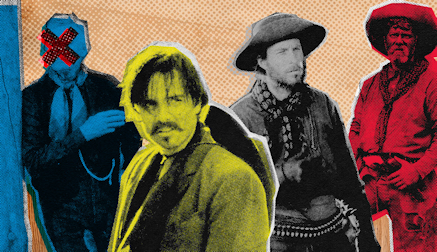
As production commenced, Michael noticed a curious dynamic unfold among the cast. In their off hours, they segregated into the same factions as their characters. Prior relationships held little weight here. For example, Tombstone was the fifth movie he had done with Bill Paxton (Morgan Earp); they’d met in London a decade earlier on Lords of Discipline. Yet on Tombstone they had dinner only once and called it an early night. He continued to bond with Powers Boothe and found kindred souls in fellow Cowboys John Corbett and Stephen Lang. Corbett was “really funny and clued in, we could keep up with each other well into the night,” he remembers. His overriding image of Stephen Lang, who plays hyperkinetic live-wire Ike Clanton, is of the actor spending hours practicing his cello. He proved to be a good sounding board for Michael’s thoughts about playing Johnny Ringo.
Tombstone had been shooting for some days when Michael started, and he quickly sensed disquiet and uneasiness about Jarre’s manner of directing. His earlier passionate commitment to his vision, once so inspiring and confidence building, was becoming a rigid intransigence and inflexibility that stifled the contributions of cast and crew. Michael recalls “hearing rumblings the studio wasn’t pleased” as well. “I didn’t sense that we were falling behind schedule, I got the feeling the studio brass felt Kevin was giving them a John Ford-like ode to the West, stately and slow, and was not capturing the pace, spirit, and energy of the screenplay.” Mostly, that meant scenes consisting of long shots — long both in their duration and in proximity to the characters, keeping many of them in single frame, pitting them against the imposing landscape. For the studio and the financial backer, that translated to limited “coverage,” or variety of shots, which narrowed their options in editing the film.
As the days went by, Michael saw Kevin’s “my way or the highway” insistence on his vision as not providing his actors sufficient creative space to bring their own visions to their roles. To many, it appeared the more they tried to persuade Kevin to accommodate their input, the more he dug in. Demoralization and dread set in. Near the end of the fourth week, Michael pulled Kevin into his trailer to try to help his director understand the obvious and growing disgruntlement. He emphasized the fundamental fact of movies: that they are a collaborative art form and good filmmakers recognize and incorporate the contributions of their collaborators. Kevin seemed to appreciate Michael’s words, but the die had been cast and he was fired the following Friday. He spotted Kevin, his bags packed, checking out of the hotel and the poignancy of that moment has stayed with him. All the years of passion, commitment, and promise Kevin had undergone to get to this point, his many disappointments at seeing Lisa Zane’s participation slashed in stages but carrying on nonetheless, only to have it all now taken away with a brutal finality, the soul-crushing weight evident on his face, crystallized in that moment and seared forever in Michael’s memory.
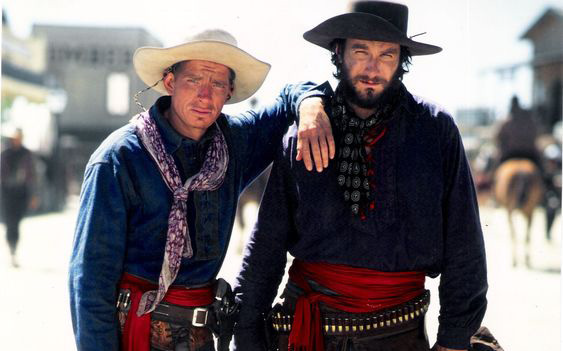 Rumors swirled that weekend that the production
might shut down. Michael soon learned, however, that
producer Jim Jacks was holed up with Kurt Russell in
a hotel room, amputating the screenplay while
replacement director George Cosmatos rushed to
Tucson. In a 2006 interview given after Cosmatos
died, Kurt said he had warned Kevin that 20 pages
had to come out of the screenplay and now he and Jim
proceeded to do just that. According to Kurt, the
way to hold the movie together while excising a big
chunk of it was to eviscerate his own role. He and
Jim then informed the cast what remained of their
roles; Jim delivering the news to the Cowboys while
Kurt advised the other Earps. Even more of Michael’s
role would be diminished when he learned that none
of Kevin’s footage would be used, thus sacrificing a
confrontation scene he’d shot with Moses himself —
Charlton Heston.
Rumors swirled that weekend that the production
might shut down. Michael soon learned, however, that
producer Jim Jacks was holed up with Kurt Russell in
a hotel room, amputating the screenplay while
replacement director George Cosmatos rushed to
Tucson. In a 2006 interview given after Cosmatos
died, Kurt said he had warned Kevin that 20 pages
had to come out of the screenplay and now he and Jim
proceeded to do just that. According to Kurt, the
way to hold the movie together while excising a big
chunk of it was to eviscerate his own role. He and
Jim then informed the cast what remained of their
roles; Jim delivering the news to the Cowboys while
Kurt advised the other Earps. Even more of Michael’s
role would be diminished when he learned that none
of Kevin’s footage would be used, thus sacrificing a
confrontation scene he’d shot with Moses himself —
Charlton Heston.Much of what got excised that weekend were scenes following the O.K. Corral gunfight that gave dimension to the “Cowboys.” In the actual history of Tombstone, these characters were far more rounded and complex than the movie depicts. Curly Bill was a part time tax collector who made the other Cowboys pay up. The Clantons and McLaurys were residents of the community and none had ever been convicted of a crime beyond public drunkenness. As ranchers, they willingly trafficked in cattle rustled from Mexico to satisfy Tombstone’s demand for beef, but by the standards of that day stealing from Mexico wasn’t stealing at all. There were no wanted posters with any of the Clantons’ or the McLaurys’ faces on them. The same couldn’t be said of Wyatt Earp at that point in time — he had a longer criminal record than any of the men killed in the fabled “Gunfight.”
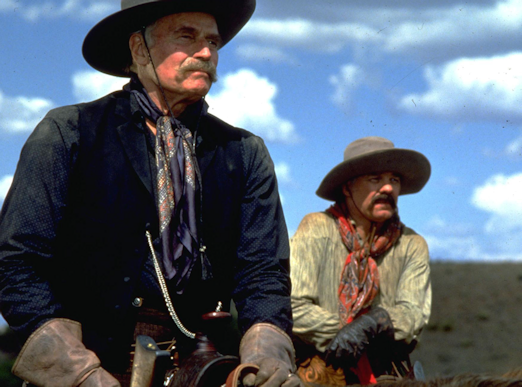
Kevin appreciated the nuance and complexity of Tombstone’s real history — it’s what drew him so resolutely to the subject — and layered it into his screenplay. But many of these scenes wound up on the hotel room floor that weekend. Turning the Cowboys from a mix of rounded characters with a case to make for themselves to a one-note band of black-hatted desperados while removing the darker shadings of Wyatt’s character proved to be the path of least resistance.
In the years since the movie’s release, a “who really directed Tombstone?” debate has emerged. George Cosmatos is the credited director, but no one associated with the film gives him anything like the responsibility for the finished product attributed to him by the “experts” at Wikipedia. The “Production” chapter of that site’s article could well have been written by Cosmatos’s publicist; reading it produced only scorn from Michael. Where the article declares the “new director brought a demanding, hard-nosed sensibility,” most on the set dismissed him as a crude and clueless lout. Michael later learned from Jim Jacks that the production was forced to pay fines of $40,000 by the Arizona Film Commission for Cosmatos’s abusive conduct. He witnessed one such incident during the movie’s opening wedding party scene, when Cosmatos bellowed at a Hispanic extra standing near Michael “tell the Mexican with the big tits to take two steps forward.”
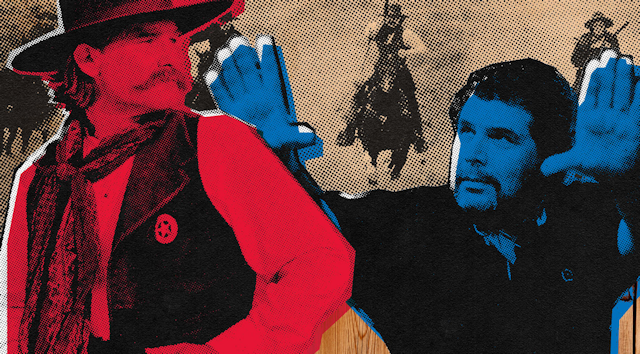 While Wikipedia claims “Cosmatos was highly focused
on accurate historical detail,” it was Kevin Jarre’s
insistence on accuracy that gave the film its
authenticity. Michael reserves his greatest
derision for this line about Cosmatos: “He liked to
treat actors as friends … and listened to ideas the
actors brought to the film.” The actors never
discussed their ideas with their director; Michael
found from their first meeting that Cosmatos had no
understanding or appreciation of the screenplay.
Indeed, Michael recalls only two conversations with
Cosmatos consisting of three words — the first to
say “hello” and the last days later to tell him to
“fuck off.”
While Wikipedia claims “Cosmatos was highly focused
on accurate historical detail,” it was Kevin Jarre’s
insistence on accuracy that gave the film its
authenticity. Michael reserves his greatest
derision for this line about Cosmatos: “He liked to
treat actors as friends … and listened to ideas the
actors brought to the film.” The actors never
discussed their ideas with their director; Michael
found from their first meeting that Cosmatos had no
understanding or appreciation of the screenplay.
Indeed, Michael recalls only two conversations with
Cosmatos consisting of three words — the first to
say “hello” and the last days later to tell him to
“fuck off.”From his arrival in Hollywood 15 years before, with the movie Escape to Athena, Cosmatos was known as a “shooter,” someone who could deliver a handsome-looking film. But he was entirely dependent on the quality of the material he was shooting. In a 2006 interview, the year after Cosmatos died, Kurt Russell declared he dictated to Cosmatos how the film would be completed, going so far as to hand him a shot list for each day’s work. That producer Andy Vajna would hand the reins over to Cosmatos isn’t surprising; rumors persist that Sylvester Stallone “ghost directed” the two previous Cinergi films Cosmatos directed, Rambo: First Blood 2 and Cobra.
Work on this article was underway when Michael visited Tombstone and spotted a new book in a store window: The Making of TOMBSTONE: Behind the Scenes of the Classic Modern Western, by retired auto executive John Farkis. He might have expected a few erroneous details, but when he saw in the opening pages that “Jarre followed Glory with Navy Seals” he tossed the book aside. Michael starred in Seals and knows Kevin had nothing to do with writing the movie.
When he next picked it up and read about Powers, Val, and Kurt sharing a hot tub, he winced before giving it a heavier toss. Kurt and Val had private residences while the rest of the cast stayed at the hotel, and Michael doesn’t recall ever seeing them there. And he finds galling the description of Powers being “lit off his ass.” “No one was closer to Powers,” he recalls indignantly. “We drove to Tucson together and we were inseparable after that.” And while there were certainly copious quantities of alcohol consumed by many — Michael calls one anecdote about a six-foot submarine sandwich in the pool a “trivial example of the debauchery that was truly going on” — all he recalls Powers ever do was “nurse a few beers back at the pool after wrap.”
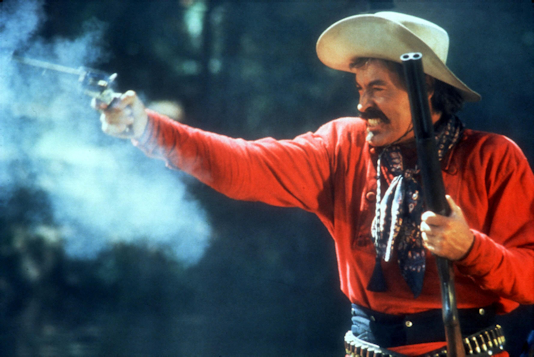
Exhaustively detailed, the book boasts four hundred interviews, rendering it amusing at times and tedious at others. It doesn’t take long to note, however, that the book suffers from a lack of interviews with principals — Kevin Jarre, Kurt Russell, George Cosmatos, Powers Boothe, Andy Vajna, Jim Jacks, Bill Paxton, Sam Elliott, Michael — who possessed indispensable insight into the creative dynamic that made TOMBSTONE come together as it did. The book’s “lost in the weeds” perspective fails to provide deeper understanding of anything important about the movie, even of the actual history that inspired and informed what’s onscreen. Kevin had painted all the characters, including the Cowboys, as richly rounded, with interwoven relationships and entanglements. But from the start, the book trips all over clichés and stereotypes. Just as in the movie, the Clanton and McLaury brothers get labeled “ruthless outlaws.” The McLaury brothers operated a working ranch on which they continued to make improvements; they were about to depart the OK Corral for their sister’s wedding in Iowa when they encountered the Earps and Doc Holliday for the final time.
The Making of TOMBSTONE declares “Kurt Russell ‘ghost directed’ Tombstone” and quoted from the interview Kurt gave after Cosmatos had died in which he discusses giving a shot list to Cosmatos each night. Kurt is undoubtedly more entitled to a “directed by” credit than Cosmatos: His attachment to the screenplay was the factor that secured the financing and he was in many of the myriad of conversations and decisions directors undertake as they assemble a movie. But when Michael is asked “did Kurt Russell direct Tombstone?,” he answers, “He didn’t direct me.”
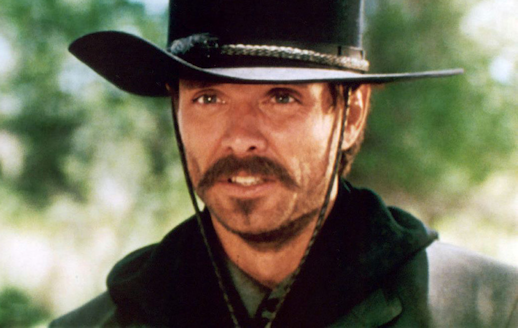 What Michael means is that the cast consisted of
such uniformly seasoned and accomplished performers
that Kurt knew they could well finish the movie
under the right circumstances. But now with the
director gone, Kurt certainly rose to the occasion
and exerted leadership that held the production
together. “He had the respect of everyone on that
set. Not since Liz Taylor has an actor consistently
warranted movie star status since childhood, and
here he is today, a significant player in
Oscar-winning movies like Quentin Tarantino’s
Once Upon A Time … in Hollywood. He’d even
played baseball professionally. I don’t think I’ve
ever worked with a better, more decent man in all my
years in the business. He had his family with him as
much as they could be there and you could tell he
was devoted to them. He’s genuinely warm-hearted and
good-natured; upbeat with an infectious laugh. He
could explode on occasion, but usually with a reason
— don’t mention rain machines in his presence. The
only time I ever saw his smile vanish was when Kevin
Costner’s name came up.”
What Michael means is that the cast consisted of
such uniformly seasoned and accomplished performers
that Kurt knew they could well finish the movie
under the right circumstances. But now with the
director gone, Kurt certainly rose to the occasion
and exerted leadership that held the production
together. “He had the respect of everyone on that
set. Not since Liz Taylor has an actor consistently
warranted movie star status since childhood, and
here he is today, a significant player in
Oscar-winning movies like Quentin Tarantino’s
Once Upon A Time … in Hollywood. He’d even
played baseball professionally. I don’t think I’ve
ever worked with a better, more decent man in all my
years in the business. He had his family with him as
much as they could be there and you could tell he
was devoted to them. He’s genuinely warm-hearted and
good-natured; upbeat with an infectious laugh. He
could explode on occasion, but usually with a reason
— don’t mention rain machines in his presence. The
only time I ever saw his smile vanish was when Kevin
Costner’s name came up.”Everyone knew Costner was about to shoot his own Wyatt Earp movie, although not as many people as Kurt knew how actively Costner had worked to torpedo Tombstone. Kurt and Costner had also both been in the running for Bull Durham before Costner got the nod. (That said, whatever “history” they may have shared didn’t stop them from making 3000 Miles to Graceland six years later.)
Kurt stated that he had warned Kevin Jarre the screenplay needed to be trimmed by twenty pages, and now, with Kevin gone, he and Jim Jacks set about doing just that. According to his 2006 interview, Kurt reasoned he was going to have to remove Wyatt’s character shadings, rendering him an “aura.” He added that “I saved most of everybody else’s stuff to do.” Just whose stuff got cut likely falls into that “it depends on whose steer is being butchered” category. “Kurt’s word is gold,” Michael says, “but here our memories differ.” Whole swaths of the third act disappeared and to the actors playing the Cowboys, the guts had been ripped out of their roles. Robert Burke, cast as Frank McLaury, received fifth billing — ahead of Sam Elliott, Bill Paxton, and Michael Rooker — yet has virtually no lines in the movie. The same is true of Thomas Haden Church and John Corbett. Both are significant talents who were then starring in popular television series (Wings and Northern Exposure, respectively) who earned acclaim for their later work. Church garnered a number of awards for Sideways, including an Oscar nomination, and Corbett had successful runs in both Sex in The City and the Big Fat Greek Wedding franchise. Yet they are scarcely more than scenery in the completed film. When Michael spoke with Powers Boothe after seeing it for the first time, he found his friend despondent.
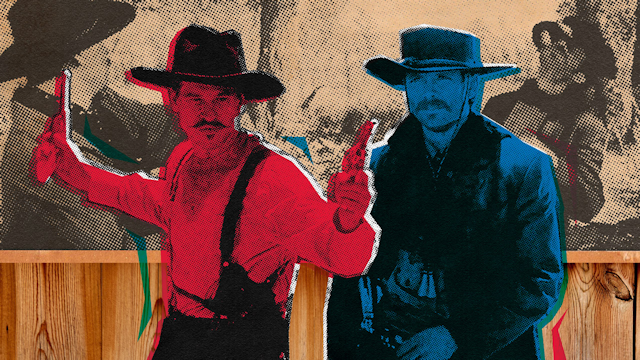 If there was
a guiding force behind the re-sculpting of Tombstone
after Kevin’s departure it amounts to this flawless
grasp of the obvious: by then Val Kilmer was
stealing the picture, and not with a gun but with a
little silver cup. “He only made me better, he made
us all better,” Michael now says. He’d caught a
glimpse of Val’s level of preparation during the
read through, and now Val seemed to disappear into
Doc’s persona. “I’ve never worked with another
actor who stayed in character to the degree Val did,
he affected that Southern accent the whole time.”
Val had lost weight for a gaunt look and to help get
a sweaty, pasty appearance, he wore glycerin all
day. “I won’t wear the stuff,” Michael says. “It’s
itchy and irritating; it lingers and becomes
painful. Val could have been spritzed whenever he
needed it, but he kept that glycerin on. He’d mumble
in Doc’s voice how miserable it was.” Michael
speculates it might have been Val’s way of
connecting with the sickness, weariness, and doom
that had singled out Doc just when, as he boasts to
Johnny Ringo, “I’m in my prime.”
If there was
a guiding force behind the re-sculpting of Tombstone
after Kevin’s departure it amounts to this flawless
grasp of the obvious: by then Val Kilmer was
stealing the picture, and not with a gun but with a
little silver cup. “He only made me better, he made
us all better,” Michael now says. He’d caught a
glimpse of Val’s level of preparation during the
read through, and now Val seemed to disappear into
Doc’s persona. “I’ve never worked with another
actor who stayed in character to the degree Val did,
he affected that Southern accent the whole time.”
Val had lost weight for a gaunt look and to help get
a sweaty, pasty appearance, he wore glycerin all
day. “I won’t wear the stuff,” Michael says. “It’s
itchy and irritating; it lingers and becomes
painful. Val could have been spritzed whenever he
needed it, but he kept that glycerin on. He’d mumble
in Doc’s voice how miserable it was.” Michael
speculates it might have been Val’s way of
connecting with the sickness, weariness, and doom
that had singled out Doc just when, as he boasts to
Johnny Ringo, “I’m in my prime.”Val did not invite or insist upon the deference that came his way; Michael recalls him as always cordial and respectful to the cast and crew, even as he remained locked in on his performance. Michael did encounter Val once with that discipline and focus slightly relaxed; “I had to talk to Kurt one day and when I went to his trailer, Val was present eating potato chips out of a tube.”
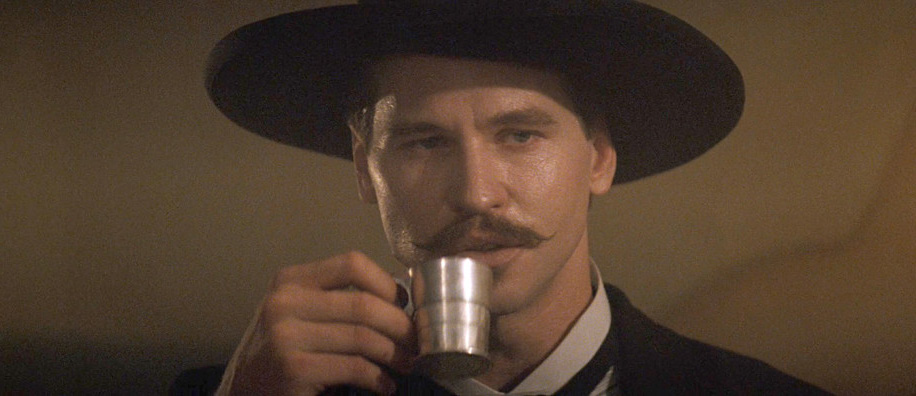 As one might expect on a set filled with
marquee-heading talents, the attention paid to Val
occasionally rankled. Michael and Powers developed a
sardonic catchword for it when it seemed to tilt to
excess: “Valitis.” Some took to calling it the “Kurt
and Val Show.” One incident positively ignited
Michael after he viewed the dailies of his drunken
“I want your blood” primal scream scene. “They spent
all morning lovingly setting up dialogue-free
reaction shots of Doc, perched on a chair on a
porch. When they shot my scene, I was out of focus.”
He let producer Jim Jacks know of his unhappiness,
but there was no time for reshoots.
As one might expect on a set filled with
marquee-heading talents, the attention paid to Val
occasionally rankled. Michael and Powers developed a
sardonic catchword for it when it seemed to tilt to
excess: “Valitis.” Some took to calling it the “Kurt
and Val Show.” One incident positively ignited
Michael after he viewed the dailies of his drunken
“I want your blood” primal scream scene. “They spent
all morning lovingly setting up dialogue-free
reaction shots of Doc, perched on a chair on a
porch. When they shot my scene, I was out of focus.”
He let producer Jim Jacks know of his unhappiness,
but there was no time for reshoots. Never in our history have we had so much knowledge at our fingertips and yet, perversely, that seems to be leading us to grow evermore gullible daily. Penetrating the welter of disinformation, misinformation, and long accepted myth to arrive at an accurate understanding and appreciation of the people and events depicted in Tombstone is a Herculean task. Kevin Jarre set out on something like that when he read about that time and place and saw in those facts the raw stuff of epic storytelling, much as he had with Glory. If anything, his commitment to his vision blinded him to the practical realities of collaborative movie making.
“It’s possible had Kevin completed the film along the lines he was going, the movie may not have found the audience it did; the final film certain fits the definition of movies as ‘happy accidents,’” Michael believes. But while Tombstone isn’t what Kevin envisioned going in — no movie ever is for any director — he’s embedded in every frame and pixel. From his sometimes-excruciating obsession with detail came a screenplay that drew top talent, and that obsession informed the decision-making of all who joined the production, from department heads to extras. Kevin’s vision was so indelibly imprinted on the production that once he left, “the movie directed itself.” Ultimately, the search for “who directed Tombstone?” circles back to where it started, with Kevin.
Infuriating for Michael, then, is what he views as the current “scapegoating” of Kevin on display in the Wikipedia article (declaring the director “was quickly overwhelmed by the job — failing to get needed shots and falling behind the shooting schedule”) and underscored in the Farkis book. The production wasn’t noticeably behind schedule, so why in the world replace Kevin after FOUR WEEKS!? Replacing a director during production is a drastic move, and when it occurs because the footage isn’t usable, the decision invariably comes in the first week. Letting Kevin work for a month and then cutting him loose (as well as jettisoning his footage) was self- efeating on the part of the producers — waiting so long resulted in, among others things, a truncated movie that needlessly fell short of what all the makers had seen in it.
The task and challenge of “setting history straight” about Tombstone isn’t simply a matter for Michael of properly recognizing Kevin Jarre’s accomplishment in getting a movie made, it amounts to a passionate plea to stop the lazy lionizing of “Wyatt Earp,” the complacent acceptance of the mythologizing of the Earps, put in motion by Wyatt himself near the end of his days and aggressively promoted by his widow, Josie. For Wyatt to become a legend, he needed to defeat loathsome foes. Thus, the need to cast the “Cowboys” as dastardly desperados when most fell well short of that description. Whatever their minor misdeeds, Billy Clanton, Tom McLaury, and Frank McLaury didn’t deserve to be mowed down in an alley by gunmen bearing badges with more outlaw in their souls than they had in theirs.
Penetrating through the shroud of long-held legend can be tough going, as Kevin came to find. But he was right to see a mother lode of great material in the truth about Tombstone, and those who are interested in the subject should seek out some of the story that failed to grace the big screen.
By Michael Biehn and Jim Anderson
